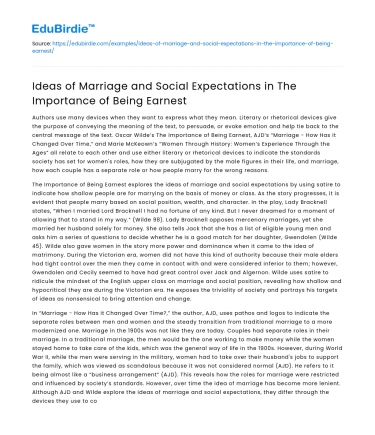Authors use many devices when they want to express what they mean. Literary or rhetorical devices give the purpose of conveying the meaning of the text, to persuade, or evoke emotion and help tie back to the central message of the text. Oscar Wilde’s The Importance of Being Earnest, AJD’s “Marriage - How Has it Changed Over Time,” and Marie McKeown’s “Women Through History: Women’s Experience Through the Ages” all relate to each other and use either literary or rhetorical devices to indicate the standards society has set for women's roles, how they are subjugated by the male figures in their life, and marriage, how each couple has a separate role or how people marry for the wrong reasons.
The Importance of Being Earnest explores the ideas of marriage and social expectations by using satire to indicate how shallow people are for marrying on the basis of money or class. As the story progresses, it is evident that people marry based on social position, wealth, and character. In the play, Lady Bracknell states, “When I married Lord Bracknell I had no fortune of any kind. But I never dreamed for a moment of allowing that to stand in my way.” (Wilde 98). Lady Bracknell opposes mercenary marriages, yet she married her husband solely for money. She also tells Jack that she has a list of eligible young men and asks him a series of questions to decide whether he is a good match for her daughter, Gwendolen (Wilde 45). Wilde also gave women in the story more power and dominance when it came to the idea of matrimony. During the Victorian era, women did not have this kind of authority because their male elders had tight control over the men they came in contact with and were considered inferior to them; however, Gwendolen and Cecily seemed to have had great control over Jack and Algernon. Wilde uses satire to ridicule the mindset of the English upper class on marriage and social position, revealing how shallow and hypocritical they are during the Victorian era. He exposes the triviality of society and portrays his targets of ideas as nonsensical to bring attention and change.
Save your time!
We can take care of your essay
- Proper editing and formatting
- Free revision, title page, and bibliography
- Flexible prices and money-back guarantee
In “Marriage - How Has it Changed Over Time?,” the author, AJD, uses pathos and logos to indicate the separate roles between men and women and the steady transition from traditional marriage to a more modernized one. Marriage in the 1900s was not like they are today. Couples had separate roles in their marriage. In a traditional marriage, the men would be the one working to make money while the women stayed home to take care of the kids, which was the general way of life in the 1900s. However, during World War II, while the men were serving in the military, women had to take over their husband's jobs to support the family, which was viewed as scandalous because it was not considered normal (AJD). He refers to it being almost like a “business arrangement” (AJD). This reveals how the roles for marriage were restricted and influenced by society’s standards. However, over time the idea of marriage has become more lenient. Although AJD and Wilde explore the ideas of marriage and social expectations, they differ through the devices they use to convey their message. To achieve this, AJD uses pathos and logos. He provides factual evidence and background knowledge that explains how marriage was in the past and how it has progressed over time. At the end of the article, he evokes the emotion of pity using pathos to persuade people to be more understanding and supportive of others and their choices.
In relation to AJD’s article, McKeown uses logos and pathos in her “Women Through History: Women’s Experience Through the Ages,” centering around the change in women's roles and their subjugation under men. In the past, they were portrayed as inferior to men because “strict expectations have been placed on women” (McKeown) but as time passed, they gained equality with more opportunities. She also mentions how the two world wars gave women the opportunity to work outside their home and take the men’s place in factories while they fought in the military, not conforming to the “traditional female role” (McKeown). The topics of marriage, women’s roles, and social expectations McKeown covers reflect AJD’s article and Wilde’s play. She also uses logos and pathos, like AJD, to get her point across. In the beginning, she uses historical facts from ancient times up to modern history. At the end of the article, although it becomes biased, she informs to give women the freedom to make their own choices and grant them the gratitude they deserve for changing social norms.
Given the points above, The Importance of Being Earnest by Oscar Wilde, “Marriage - How Has it Changed Over Time” by AJD, and “Women Through History: Women’s Experience Through the Ages” by Marie McKeown all relate to each other through their topics and devices they use to convey their message. All three texts explore the subjugation of women, the basis of marriage, and the separate roles between men and women. While Wilde uses satire and irony to ridicule Victorian society, McKeown and AJD use logos and pathos to create change, all indicating the influence of society and the standards they set on marriage and women’s roles.






 Stuck on your essay?
Stuck on your essay?

